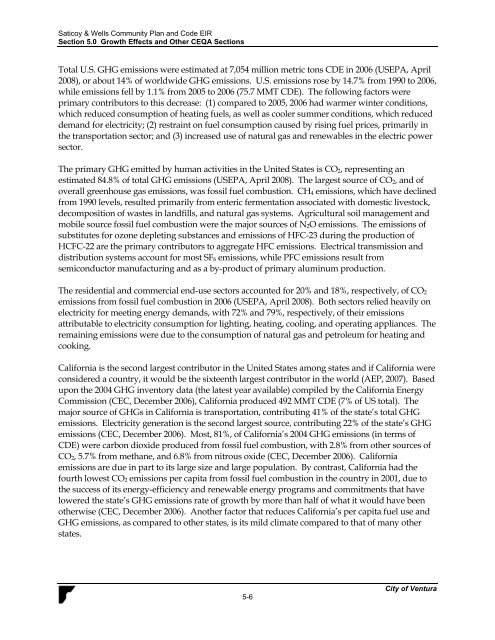Saticoy & Wells Community Plan & Development ... - City Of Ventura
Saticoy & Wells Community Plan & Development ... - City Of Ventura
Saticoy & Wells Community Plan & Development ... - City Of Ventura
Create successful ePaper yourself
Turn your PDF publications into a flip-book with our unique Google optimized e-Paper software.
<strong>Saticoy</strong> & <strong>Wells</strong> <strong>Community</strong> <strong>Plan</strong> and Code EIRSection 5.0 Growth Effects and Other CEQA SectionsTotal U.S. GHG emissions were estimated at 7,054 million metric tons CDE in 2006 (USEPA, April2008), or about 14% of worldwide GHG emissions. U.S. emissions rose by 14.7% from 1990 to 2006,while emissions fell by 1.1% from 2005 to 2006 (75.7 MMT CDE). The following factors wereprimary contributors to this decrease: (1) compared to 2005, 2006 had warmer winter conditions,which reduced consumption of heating fuels, as well as cooler summer conditions, which reduceddemand for electricity; (2) restraint on fuel consumption caused by rising fuel prices, primarily inthe transportation sector; and (3) increased use of natural gas and renewables in the electric powersector.The primary GHG emitted by human activities in the United States is CO 2 , representing anestimated 84.8% of total GHG emissions (USEPA, April 2008). The largest source of CO 2 , and ofoverall greenhouse gas emissions, was fossil fuel combustion. CH 4 emissions, which have declinedfrom 1990 levels, resulted primarily from enteric fermentation associated with domestic livestock,decomposition of wastes in landfills, and natural gas systems. Agricultural soil management andmobile source fossil fuel combustion were the major sources of N 2 O emissions. The emissions ofsubstitutes for ozone depleting substances and emissions of HFC-23 during the production ofHCFC-22 are the primary contributors to aggregate HFC emissions. Electrical transmission anddistribution systems account for most SF 6 emissions, while PFC emissions result fromsemiconductor manufacturing and as a by-product of primary aluminum production.The residential and commercial end-use sectors accounted for 20% and 18%, respectively, of CO 2emissions from fossil fuel combustion in 2006 (USEPA, April 2008). Both sectors relied heavily onelectricity for meeting energy demands, with 72% and 79%, respectively, of their emissionsattributable to electricity consumption for lighting, heating, cooling, and operating appliances. Theremaining emissions were due to the consumption of natural gas and petroleum for heating andcooking.California is the second largest contributor in the United States among states and if California wereconsidered a country, it would be the sixteenth largest contributor in the world (AEP, 2007). Basedupon the 2004 GHG inventory data (the latest year available) compiled by the California EnergyCommission (CEC, December 2006), California produced 492 MMT CDE (7% of US total). Themajor source of GHGs in California is transportation, contributing 41% of the state’s total GHGemissions. Electricity generation is the second largest source, contributing 22% of the state’s GHGemissions (CEC, December 2006). Most, 81%, of California’s 2004 GHG emissions (in terms ofCDE) were carbon dioxide produced from fossil fuel combustion, with 2.8% from other sources ofCO 2 , 5.7% from methane, and 6.8% from nitrous oxide (CEC, December 2006). Californiaemissions are due in part to its large size and large population. By contrast, California had thefourth lowest CO 2 emissions per capita from fossil fuel combustion in the country in 2001, due tothe success of its energy-efficiency and renewable energy programs and commitments that havelowered the state’s GHG emissions rate of growth by more than half of what it would have beenotherwise (CEC, December 2006). Another factor that reduces California’s per capita fuel use andGHG emissions, as compared to other states, is its mild climate compared to that of many otherstates.5-6<strong>City</strong> of <strong>Ventura</strong>
















